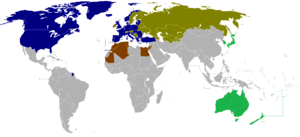Atlantic Treaty Association
.jpg)
The Atlantic Treaty Association (ATA) is an umbrella organization which draws together political leaders, academics, military officials, and diplomats to support NATO. ATA is an independent organization separate from NATO.[1][2][3]
ATA was created on 18 June 1954.[2] Since the end of the Cold War and the dissolution of the Warsaw Pact, the role of the Atlantic Treaty Association has changed considerably. In 1992 the ATA Constitution was amended to accommodate associate members and observers from non-NATO countries. Given NATO's shifting nature, ATA now works beyond the borders of the Euro-Atlantic, operating in Central and Eastern Europe, the Mediterranean, and the South Caucasus. Following the ascension of the new NATO countries in 1999 and 2004, ATA membership expanded considerably, and its security focus has shifted south and eastward.[4][5][2]
ATA is active in NATO's Partnership for Peace (PfP) and Mediterranean Dialogue programs, and is increasingly engaged with officials and institutions based in members of the Istanbul Cooperation Initiative (ICI) and Partners Across the Globe.
The Atlantic Treaty Association's stated mission is to support the values set forth in the North Atlantic Treaty: Freedom, Liberty, Peace, Security, and the Rule of law. As such, ATA aims to serve as a forum for debate in which member associations can realize common interests and democratic goals.[2][1] The youth branch of the ATA, the Youth Atlantic Treaty Association (YATA) was created in 1996.[2] YATA seeks to educate and promote debate among youth in order to create responsible future political leaders who have an understanding of the values set forth in the North Atlantic Treaty.[4]
Structure
ATA is composed of three main bodies: the Assembly, the Bureau, and the Council.[1][5]
The Assembly
The Assembly is the top decision-making body of the ATA and is composed of delegates from Member, Associate Member and Observer Member associations. With the exception of Observer Members, each delegate has one vote and resolutions are passed by a simple majority. In addition to the delegates, members of the press and academic community, government and military officials, and international observers may attend the General Assembly meetings, which are held once a year.[5][1][6]
The Bureau
The Bureau includes the president, vice presidents, secretary general, treasurer, YATA president and the legal adviser. Members of the Bureau assist in carrying out the decisions of the Council and the Assembly and aid in policy matters.[5]
The Council
The Council comprises Bureau members plus up to three delegates from each of the ATA Member, Associate Member and Observer Member associations. ATA allows the Council to take action on its behalf, with the recommendation of the Bureau and the approval of the Assembly. The Council holds two meetings a year: once at NATO Headquarters and once in a host country.[5]
Member organizations
NATO countries
- Albania, Albanian Atlantic Association
- Belgium, Association Atlantique Belge
- Bulgaria, The Atlantic Club of Bulgaria
- Canada, NATO Association of Canada
- Croatia, Atlantic Council of Croatia
- Czech Republic, Czech Atlantic Commission
- Denmark, Atlantsammenslutningen
- Estonia, Estonian Atlantic Treaty Association
- France, Association Française pour la Communauté Atlantique
- Germany, Deutsche Atlantische Gesellschaft
- Greece, Greek Association for Atlantic and European Cooperation
- Hungary, Hungarian Atlantic Council
- Iceland, Samtök um Vestraena Samvinnu
- Italy, Comitato Italiano Atlantico
- Latvia, Latvian Transatlantic Organization
- Lithuania, Lithuanian Atlantic Treaty Association
- Netherlands, The Atlantische Commissie
- Norway, Den Norske Atlanterhavskomite
- Portugal, Comissão Portuguesa do Atlântico
- Romania, Euro-Atlantic Council
- Slovak Republic, GLOBSEC
- Slovenia, The Euro-Atlantic Council of Slovenia
- Spain, Asociación Atlantica Española
- Turkey, Türk Atlantik Andlasmasi Dernegi
- United Kingdom, Atlantic Council of the United Kingdom
- United States, Atlantic Council
Partnership for Peace countries
- Armenia, Atlantic Association of Armenia
- Azerbaijan, Azerbaijan Atlantic Cooperation
- Former Yugoslav Republic of Macedonia, Euro-Atlantic Club of the Republic of Macedonia
- Georgia, Georgian Association of Atlantic Collaboration
- Serbia, Atlantic Council of Serbia
- Sweden, Swedish Atlantic Council
- Ukraine, The Atlantic Council of Ukraine
Former presidents
2003–2008: Ambassador Bob Hunter, former US Ambassador to NATO
2008–2015: Dr. Karl A. Lamers MdB
2015–present: Fabrizio Luciolli
References
- 1 2 3 4 "Atlantic Treaty Association (ATA)". cepolicy.org. Archived from the original on 2016-08-05. Retrieved 2017-02-21.
- 1 2 3 4 5 "Atlantic Treaty Association and Youth Atlantic Treaty Association". NATO. 7 April 2016.
- ↑ "Atlantic Treaty Association – issuu". issuu.com. Retrieved 2017-02-21.
- 1 2 "About Us | YATA International". yata-international.org. Retrieved 2017-02-21.
- 1 2 3 4 5 "NATO – Atlantic Treaty Association". NATO Official Website.
- ↑ "Atlantic Treaty Association General Assembly". NAOC. Retrieved 2017-02-21.
